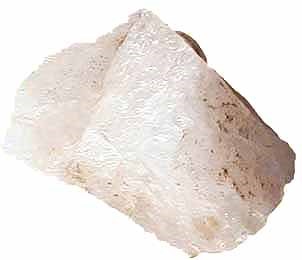
Quartz monzonite may sound complicated, but it is only a type of granite. Granite is a crystalline, igneous rock composed mainly of quartz, orthoclase, and microcline. The name monzonite means that the magma that created the rock had approximately equal amounts of sodium and calcium-rich feldspars. When "quartz" is added to the title, it means that a large amount of silica was present in the magma. Silica, when cooled, becomes quartz. QuartzThe name originates from the German "quarz," or crystal. Quartz is composed purely of silicon dioxide (Si3O2) and is colorless when pure. Impurities such as iron oxide (rose quartz) or many tiny bubbles (milky quartz can give it many colors). This hard mineral breaks with a smoothly curved surface, and is one of the most common minerals in the Earth's crust. Quartz occurs in every class of rock and in every conceivable form. In modern times, quartz is used in glass manufacture, and as an oscillator to control frequencies in radios or watches LocationOne can find quartz in nearly any of the rocks at Black Canyon. It can be useful as a geologic thermometer because the type of crystalline form indicates specific temperatures at formation. 
NPS Photo Vernal Mesa Quartz MonzoniteVernal Mesa Quartz Monzonite derives its name from Vernal Mesa which encompasses the majority of the south rim of Black Canyon. Quartz monzonite contains small amounts of sodium and potassium, and more calcium than granite. It's similar in appearance to granite but is different chemically and mineralogically. Vernal Mesa Quartz Monzonite is dark gray and course grained. LocationThis quartz monzonite does not run through the entire canyon and exists in separate "intrusive bodies." The largest one covers an area of approximately three square miles and stretches from Rock Point to Warner Point on the south rim. This is also the most dramatic section of the park, containing plunging cliffs, imposing monoliths, and the Narrows section of the Gunnison River. 
NPS/Troy Hunt Curecanti Quartz MonzoniteCurecanti Quartz Monzonite, named for the Curecanti Needle in the Morrow Point Reservoir, differs from the Vernal Mesa Monzonite by being lighter and finer grained. Moving as a pluton (large body) miles deep below the surface, magma intruded into the existing schists and gneisses. It devoured the rock in its path, folding them in and half-way digesting them. At times, this blob of molten rock would push the metamorphic rock out of the way. Slowly the magma cooled and individual crystals solidified. This type of event occurred three times over the ages while the metamorphic rock was still deep in the earth. LocationIt is more exposed and visible in 1,000 ft (305 m) vertical cliffs of the upper Black Canyon. |
Last updated: April 24, 2025
